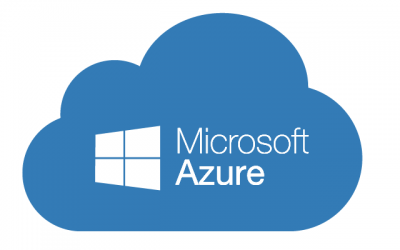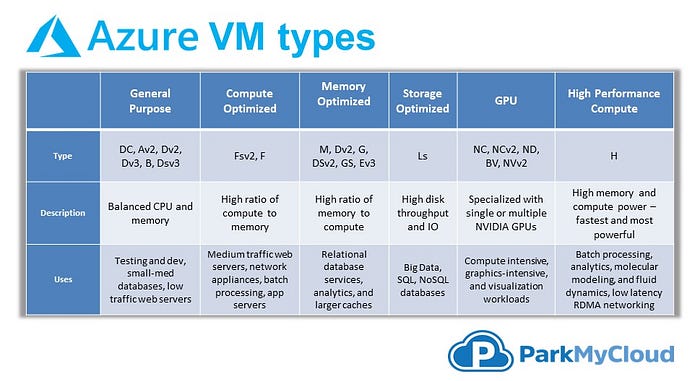Microsoft Azure VM Types Comparison

Microsoft Azure VM types come in a wide range optimized to meet various needs. Machine types are specialized, and vary by virtual CPU (vCPU), disk capability, and memory size, offering a number of options to match any workload.
With so many options available, finding the right machine type for your workload becomes confusing — which is why we’ve created this overview of Azure VM types (as we did before with EC2 instance types, and Google Cloud machine types). Note that while AWS EC2 instance types have names associated with their purpose, Azure instance type names are simply in a series from A to N.The chart below and written descriptions are a brief and easy reference, but remember that finding the right machine type for your workload will always depend on your needs.

General Purpose
General purpose VMs are suitable for balanced CPU and memory, making them a great option for testing and development, smaller to medium databases, and web servers with lower traffic:
DC-series
The latest family of virtual machines stand out for data protection and code confidentiality. SGX technology and a 3.7GHz Intel XEON E-2176G Processor back these machines, and in conjunction with Intel Turbo Boost Technology, they can go up to 4.7 GHz.
Av2 Series
A-series VMs have a CPU-to-memory ratio that works best for entry-level workloads, like those for development and testing. Sizing is throttled for consistent processor performance to run the instance.
Dv2-series
Dv2 VMs boast powerful CPUs — roughly 35% faster than D-series VMs — and optimized memory, great for production workloads. With the same memory and disk configurations as the D-series, based upon either a 2.4 GHz or 2.3 GHz processor and Intel Boost Technology, they can go to up to 3.1 GHz.
Dv3-series
With expanded memory and adjustments for disk and network limits, the Dv3 series Azure VM type offers the most value to general purpose workloads. Best for enterprise applications, relational databases, in-memory caching, and analytics.
B-series
Similar to the AWS t-series machine type family, B-series VMs are burstable and ideal for workloads that do not rely on full and continuous CPU performance. Customers can purchase a VM size that builds up credits when underutilized, and the accumulated credits can be used as bursts — spikes in compute power that allow for higher CPU performance when needed. Use cases for B-series VM types include development and testing, low-traffic web servers, small databases, micro services, and more.
Dsv3-series
With premium storage and a 2.4 or 2.3 GHz Intel Xeon processor that can achieve 3.5 GHz thanks to Intel Turbo Boost Technology 2.0, the Dsv3-series is best suited for most production workloads.
Compute Optimized
Compute optimized Azure VM types offer a high CPU-to-memory ratio. They’re suitable for medium traffic web servers, network appliances, batch processing, and application servers.
Fsv2-series
With a base core frequency of 2.7 GHz and a maximum single-core turbo frequency of 3.7 GHz, Fsv2 series VM types offer up to twice the performance boost for vector processing workloads. Not only do they offer great speed for any workload, the Fsv2 also offers the best value for its price based on the ratio of Azure Compute Unit (ACU) per vCPU.
F-series
F-series Azure VM types are great for workloads that require speed thanks to the 2.4 GHz Intel Xeon processor, reaching speeds up to 3.1 GHz with the Intel Turbo Boost Technology 2.0. The F-series is your best bet for fast CPUs but not so much when it comes to memory or temporary storage per vCPU. Analytics, gaming servers, web servers, and batch processing would work well with the F-series.
Memory Optimized
Memory optimized VM types are higher in memory as opposed to CPU, and best suited for relational database services, analytics, and larger caches.
M-Series
Enterprise applications and large databases will benefit most from the M-series for having the most memory (up to 3.8 TiB) and the highest vCPU count (up to 128) of any VM in the cloud.
Dv2-series, G-series, and the DSv2/GS
For applications that require fast vCPUs, reliable temporary storage, and demand more memory, the Dv2, G, and DSv2/GS series all fit the bill for enterprise applications. The Dv2 series offers a speed and power with a CPU about 34% faster than that of the D-series. Based on the 2.3 and 2.4 GHz Intel Xeon® processors and with Intel Turbo Boost Technology 2.0, they can reach up to 3.1 GHz. The Dv2-series also has the same memory and disk configurations as the D-series.
Ev3-series
The Ev3 follows in the footsteps of the high memory VM sizes originating from the D/Dv2 families. This Azure VM types provides excellent value for general purpose workloads, boasting expanded memory (from 7 GiB/vCPU to 8 GiB/vCPU) with adjustments to disk and network limits per core basis in alignment with the move to hyperthreading.
Storage Optimized
For big data, SQL, and NoSQL databases, storage optimized VMs are the best type for their high disk throughput and IO.
Ls-series
VMs provide as much as 32 vCPUs with the Intel® Xeon® processor E5 v3 family. The Ls-series comes with the same CPU performance as the G/GS-Series and 8 GiB of memory per vCPU. This type works best applications requiring low latency, high throughput, and large local disk storage.
GPU
GPU VM types, specialized with single or multiple NVIDIA GPUs, work best for video editing and heavy graphics rendering — as in compute-intensive, graphics-intensive, and visualization workloads.
- NC, NCv2, NCv3, and ND sizes are optimized for compute-intensive and network-intensive applications and algorithms.
- NV and NVv2 sizes were made and optimized for remote visualization, streaming, gaming, encoding, and VDI scenarios.]
High Performance Compute
For the fastest and most powerful virtual machines, high performance compute is the best choice with optional high-throughput network interfaces (RDMA).
H-series
For the latest in high performance computing, the H-series Azure VM was built for handling batch workloads, analytics, molecular modeling, and fluid dynamics. These 8 and 16 vCPU VMs are built on the Intel Haswell E5–2667 V3 processor technology featuring DDR4 memory and SSD-based temporary storage.
And besides sizable CPU power, the H-series provides options for low latency RDMA networking with FDR InfiniBand and different memory configurations for supporting memory intensive compute requirements.
What Azure VM type is right for you?
With six virtual machine types belonging to multiple families and coming in a range of sizes, how do you determine the right Azure VM type for your workload? The good news is that with this many options, you’re bound to find the right type to meet your computing needs — as long as you know what those needs are. With good insight into your workload, usage trends, and business needs, you’ll be able to find the Azure VM type that’s right for you.
Originally published at www.parkmycloud.com on October 16, 2018.
